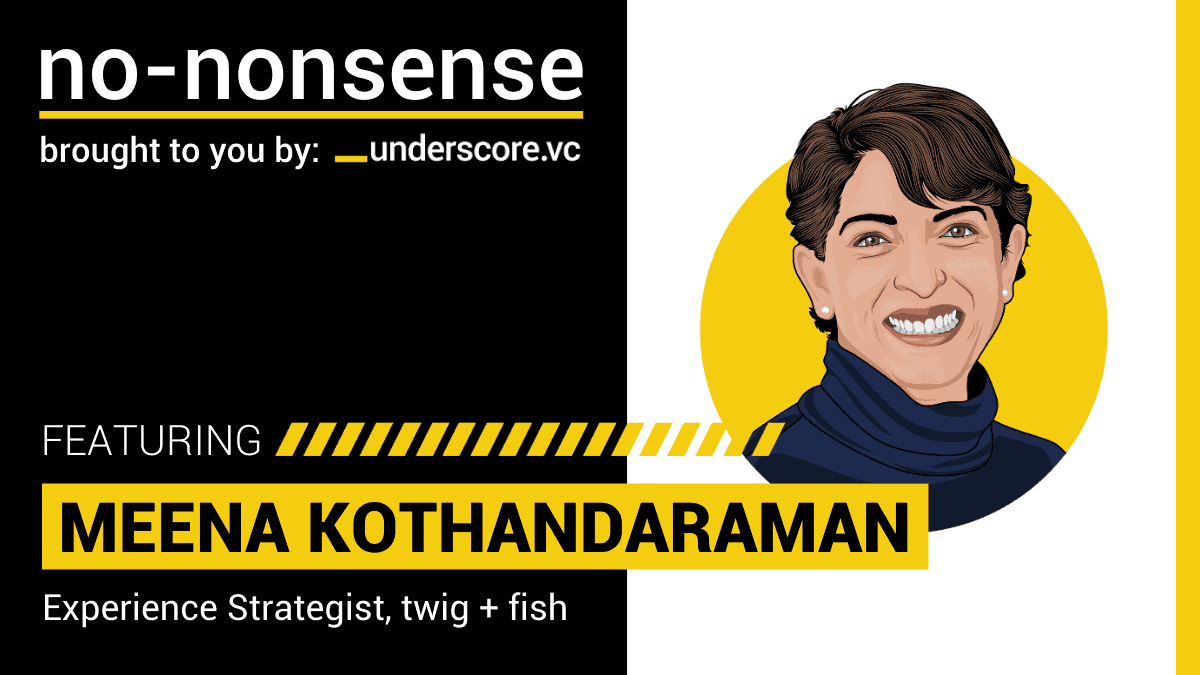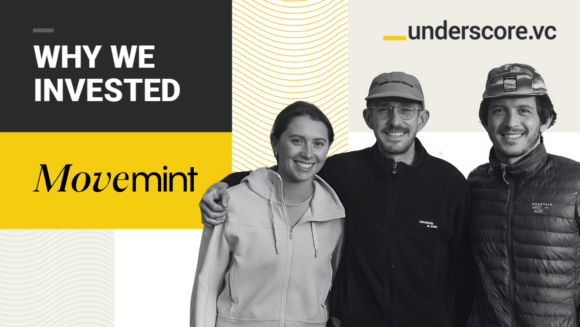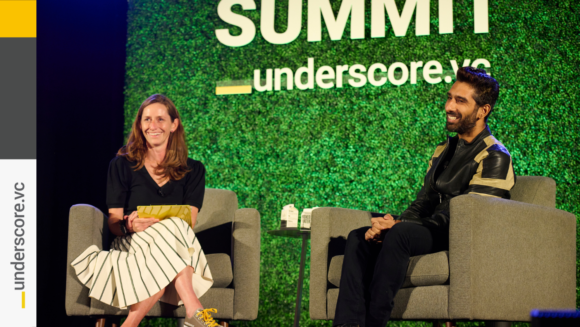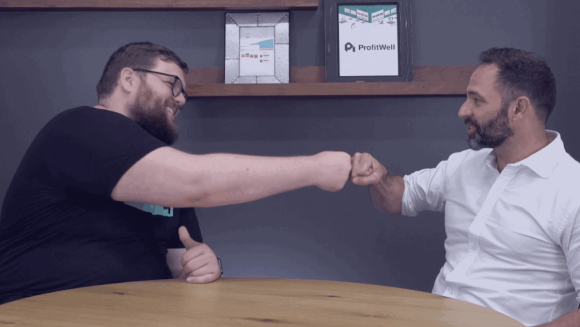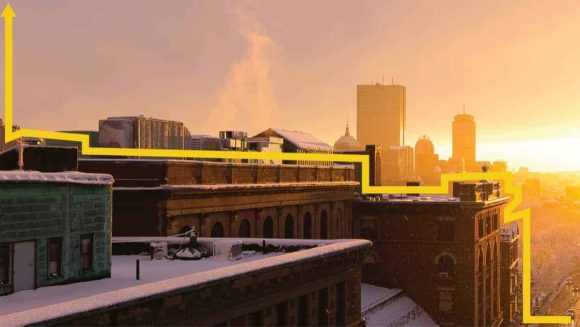Following the 2019 Core Summit, we’re releasing “No-Nonsense,” a content series featuring no-nonsense advice on the not so obvious paths to success. Check back every Wednesday for the release of each interview with our 2019 Core Summit speakers! This week we dig-into human-centered design with Meena Kothandaraman.
For this Wednesday’s installment of No-Nonsense, we spoke with Meena Kothandaraman, who is the co-founder of twig + fish a human-centered research and strategy consulting firm. There, she focuses on human-centered design and elevates the human story into organizational and quantitative processes.
Meena’s almost-30 years of experience ranges from lecturing at Bentley University to hosting a cooking show, to writing a children’s book. She’s also a mom of two who loves to pump up crowds at speaking engagements with the YMCA as her walk-on music.
Below is our Q&A with Meena, where she explains what advice she would put on a billboard, how she prioritizes empathy in her work, and what exactly an experience strategist is. You’ll also find an awesome video of Meena speaking at our 2019 Core Summit, where she took us to school on human-centered design.
How did you become an experience strategist and where does your work focus?
During my undergrad, I had a co-op at a company that intended to use me for my computer science and business background. I ended up meeting the lone human factors resource at the company, whose job was to play the role of somebody who – in today’s language – really thinks about how to keep things human-centered.
I found her work in human-centered design to be fascinating.
When I finished my undergrad, I went back to that company and worked on a project with her to study how people use payphones. We studied people’s behaviors and use scenarios in order to design a better payphone interface. It was a great way to find out that I enjoy studying people.
I know the title “experience strategist” is a bit bizarre, but at heart, I am a qualitative researcher. That’s what I do, and once I started, I just never looked back. I focus on positioning qualitative research as a strategic tool, that ultimately directly contributes to the overall experience designed.
In your work, what is your North Star?
In every study that we run, I want to make sure that the client feels a sense of accomplishment at the end of it. I want them to have learned something and understand how the human story contributes to what they create
“Research” can be a bit of a daunting term to people, but it’s really just trying to understand gaps in knowledge. Our goal is to make it very structured, rigorous, dependable, and credible so that there’s high confidence in how we address knowledge gaps.
Do you have a specific mantra that drives your work?
For me, it’s “be humble and curious.” I never want to go in assuming that I know everything about the team who creates the experience, or the people who consume it. Honestly, I don’t really consider myself an expert, because there’s always something to learn – more specifically, there’s always something about people to learn.
You plan to conduct a 15-second exercise on “experiences that blow your mind away” at the Core Summit. What is that and what do you expect the audience to get from it?
I give attendees 10 seconds to think of five incredible experiences. Anything that you touched during your day, or anything that you’ve touched only once that blows your mind away. It could be a service, an interface, a space, a product – it doesn’t matter.
I’ve asked this question to thousands of people. The average amount that people come up with is about two to three.
The thing that I want people to do is to reflect for a moment. We have tons of experiences every hour, and we can only come up with two to three?!
I’d like startups to just think about this: Can I actually tell a human story of somebody using my product? Can I show how my design will service an opportunity, or a need, and show clear value? Without understanding the human story, we often find ourselves guessing at what “might” solve a problem.
''Can I actually tell a human story of somebody using my product? Without understanding the human story, we often find ourselves guessing at what *might* solve a problem'' - @meena_ko Click To TweetIf you’re an airline, and you cannot say, “I actually watched people use my reservation app to get a new ticket when they had to rebook,” that’s a problem, because you need to know the human perspective to what you’re selling. This is regardless of the advanced technology you might be employing – you have to be able to position what you offer meaningfully in someone’s life.
You use research as a way to anchor experiences – Tell me about the process and the important takeaways for startups at the earliest stage.
Our process is focused on understanding the story of the people who consume and produce designs. At the earliest stage, startups need to focus on ensuring they stay connected with that human story. Research helps generate and capture the stories, as well as the emotional aspect contained within each story. Experiences become meaningful when they create a relationship: startups need to keep track of the emotions involved and leverage that into their designs.
More often than not, many organizations start to think about moving quickly toward quantitative measurements to capture emotions and human data. Without a solid basis and understanding of the depth of that data through qualitative research, quantitative research yields less valuable results.
What are tactics to ensure that you’re able to recount a human story of how your product is used in your company?
It’s making sure that that there is a central repository for questions that people have. It is also making sure that not just one or two people hear the story that addresses the question. Socialize the human story, and allow everyone a chance to rely on and relate to that human story. Research ultimately brings the organization closer to the people. You need quantitative and qualitative to work together to give you holistic answers to your questions.
Conducting research also serves as inspiration to product and design teams, by forcing them to think beyond the obvious. Often, we can learn a lot from other industries, and even extreme users, who might exploit our designs and push them to use cases we might not have envisioned.
What are some mistakes that you made early on in your work that you wish you could have avoided?
I wish I had known to match my confidence and capabilities earlier so I could have helped more companies. I definitely had the capability, but I lacked the voice. I didn’t know the right way to present the information I knew mattered.
What do you find experience designers are wasting time on the most?
I actually think there’s an area that designers aren’t spending enough time on these days, and that’s taking the time to understand people.
It’s very hard to be a designer today. It’s fun, but sometimes I’ll notice that designers lose their spark. It’s because they are often creating something mandated, or possibly, something out of their own imagination. This might work for a few iterations, but after some time, designers need to listen again to the human story. And when they see a gap that they can solve, their mind races to a plethora of options.
What is the best advice you ever received and who did it come from?
One of the best pieces of advice is from Nancy Dickenson, a strategist herself and my boss 21 years ago.
She told me to always think from the lens of somebody else and be mindful of the words that you use. Your perspective might be right, but you cannot assume that them not seeing it means they’re not smart enough to get it.
How did you handle adversity and doubt? What advice do you have for earliest stage entrepreneurs who might be struggling with adversity and doubt?
In the early stages, there’s always going to be risks. I think everybody knows that, but risk just means you’re going into the unknown. You have to ask yourself what will give confidence to decisions you make, and often, that comes from many different sources, but primarily, evidence.
The typical entrepreneurial mind is filled with questions without all the answers. When you go into the unknown, a good way is to always dump out the questions that you have in your mind. Scrutinize how you get answers to your questions, and reflect on what answers give you high confidence (that often means less assumption and bias).
When you’re in that phase, my recommendation is to put all the questions down on Post-it notes. Get the questions out of your head, because then you can actually see what your issues are and ask yourself how well you can address them.
Over the years, what has become a non-negotiable for you in business?
Respecting the trade and what it means to do research well. If clients say, “We need to do this in half the time,” to me, they’re saying “I know this is a 100-hour project, but we need you to do it in 50 hours and keep the scope the same.”
Would you tell a developer that you need 100 hours of work in 50 hours? How about a CEO? No – it’s the same in research, so for me, that’s non-negotiable. We make sure that we care for ourselves by making what goes into designing a research study very transparent. When everyone partakes in that process and understands the collective value, there is more appreciation for the detail and creativity needed to be a researcher.
What business advice would you put on a billboard?
It would be that “Don’t forget that real people are involved in every experience”
It’s real people who use your products. We’re still a world full of humans, and connection and emotions will exist in every product created. It’s not just monetary, because people will pay more for a good experience. At some point in the overall experience, real people will need to interact regardless of the advanced technology we use. There will still be people in driverless cars, or a customer on an IM with a chatbot. We cannot overlook the real people.
What is keeping you up at night? Why?
A challenge that’s keeping me up at night is the dilution of the craft. Designers are now becoming researchers and developers. Many people think “what is so difficult about asking questions?” It takes a lot of skill to be able to craft a research study that allows people to open up and share their own stories. We cannot be an expert in everything.
Respect the craft and the trade of research. Respect what it means to by positioning it appropriately in the organization because there’s a hell of a lot of creativity required to succeed in it.
Do you have any bold predictions for the future of the industry? What does the future of this industry look like to you?
I feel – while it’s happening slowly – that people and organizations are now starting to realize that you cannot succeed without really understanding people.
It’s a very slow uptake, but I’m a cup half full kind of girl. I’m going to remain positive and say people are starting to catch that wind. There are many more benefits to research and experience design than meets the eye.
– – – – – – –
